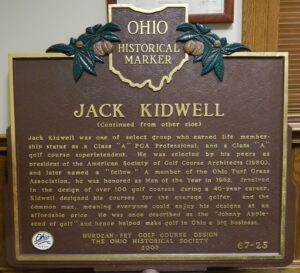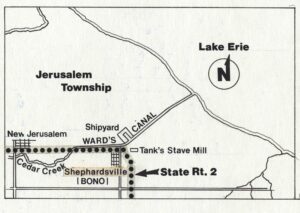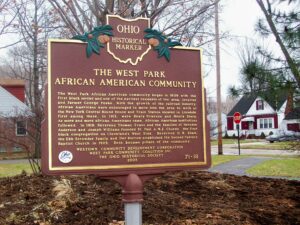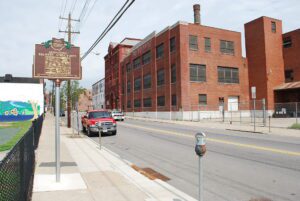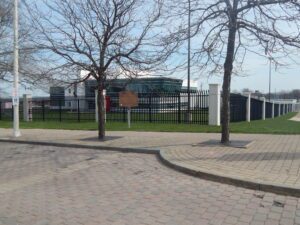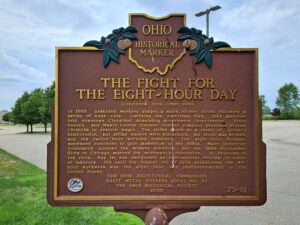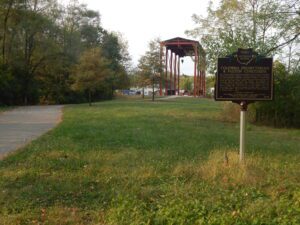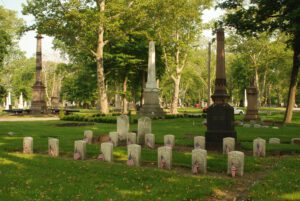, OH
Born on September 21, 1918, golf course architect Jack Kidwell attended Columbus Central High School where he became the Ohio School State Golf Champion in 1937. Kidwell was the owner and operator of Beacon Light Golf Course from 1937-1971. He was inducted into both the Southern Ohio PGA Hall of Fame and the Ohio Golf Association Hall of Fame in 1997. He was the founding father of Hurdzan/Fry Golf Course Design and the inspirational leader to this day. Kidwell was a true giant of the golf industry and has been named the person having the most influence on golf in the state of Ohio over the past 200 years. He was married to his wife Geraldine “Jerry” Kidwell for 57 years and they had four daughters, Sally, Shirley, Kathy, and Jody. Jack Kidwell died on April 29, 2001.
, OH
To utilize the area’s rich timber stands, Detroit industrialist Eber Brock Ward (1811-1875) built a canal around 1870 in what was then Oregon Township, Lucas County. Known as Ward’s Canal, it stretched approximately 2-3/4 miles through wetlands to Lake Erie. Through the canal passed timber sawn at Ward’s mills and ships from his boatyards. Two settlements formed to house workers: Shepherdsville, renamed Bono in 1898, and New Jerusalem. (Continued on other side)
, OH
The West Park African American community began in 1809 with the first black settler and one of the earliest residents of the area, inventor and farmer George Peake. With the growth of the railroad industry, African Americans were encouraged to move into the area to work at the New York Central Round House and Train Station located in Linndale. First among these, in 1912, were Beary Frierson and Henry Sharp. As more and more African Americans came, African American institutions followed. In 1919, Reverend Thomas Evans and the families of Herndon Anderson and Joseph Williams founded St. Paul A.M.E. Church, the first black congregation on Cleveland’s West Side. Reverend D.R. Shaw, the Ebb Strowder family and Iler Burrow established the Second Calvary Baptist Church in 1923. Both became pillars of the community.
, OH
The Brewery District contains the majority of Cincinnati’s remaining breweries and associated structures such as icehouses, bottling buildings, offices, and stables. With the first brewery north of Liberty Street founded in1829, German immigrants fueled the growth of the brewing industry; by 1891, Cincinnati breweries produced over four barrels of beer per resident annually, almost twice as much as any other city in the nation. The brick breweries were typically designed in the Romanesque Revival style, and larger complexes often covered multiple city blocks. To produce the lager style beer common by 1860, typically very deep basements were dug or tunnels were cut into hillsides for the lagering process. At the height of production, 18 of the 36 breweries in greater Cincinnati were operating in Over-the-Rhine and the West End. Prohibition in 1919 closed most of the breweries permanently.
, OH
Isaac Campbell Kidd, Sr. was born in Cleveland in 1884. He entered the United States Naval Academy in 1902 and dedicated his life to the Navy. While an ensign, he sailed around the world with the “Great White Fleet” from 1907 to 1909. During the 1920s and 1930s, he held numerous flag commands. Promoted to Rear Admiral in 1940, he was assigned as Commander, Battleship Division ONE. On December 7, 1941, Kidd was aboard the battleship USS Arizona in Pearl Harbor, Hawaii. During the surprise Japanese air raid, bombs detonated her ammunition. The resulting explosion sank the ship, causing the loss of 1,100 crewmen, including Admiral Kidd. He was posthumously awarded the Medal of Honor for his bravery. Two destroyers were named in honor of this World War II naval hero: USS Kidd (DD-661), 1943-1964 (still afloat as the centerpiece of the Louisiana Naval War Memorial, Baton Rouge), and USS Kidd (DDG-993), 1981-1998.
, OH
Organized efforts to establish an eight-hour workday existed as early as 1866 in the United States. The Cleveland Rolling Mills Strikes of 1882 and 1885, as part of this almost-70-year struggle, contributed to the establishment of the eight-hour workday. Both strikes challenged the two-shift, twelve-hour workday in addition to seeking recognition of the Amalgamated Association of Iron, Steel, and Tin Workers. The first strike – by English, Welsh, and Irish skilled workers – was at the Newburgh Rolling Mills, a major producer of steel rails for the rapidly expanding railroad industry that once stood near this site. It was quickly broken when unskilled Polish and Czech immigrants, unaware of the ongoing labor dispute, were hired. The strike ended when these new workers did not support the union. (continued on other side)
, OH
The cemetery dates to 1794 and is comprised of two adjacent cemeteries: Columbia Presbyterian Cemetery and Fulton Cemetery. Another cemetery, the Fulton Mechanics Cemetery, had been in Fulton, a village along the Ohio River and a center of boat-building and steamboat construction during the first half of 19th century. Together, the cemeteries are the burial places of Jacob Allen, John Campbell, John Langdon, and other veterans of the Revolutionary War. It is also believed that William Brown is buried here. Brown was one of three soldiers during the Revolutionary War to receive the Badge of Military Merit, predecessor of the Purple Heart. The cemetery was listed on the National Register of Historic Places in 1979. (Continued on other side)
, OH
Howard Daniels, who lived from 1815-1863, was a noted architect and landscape gardener. Over the course of his life, he designed six Ohio and New York cemeteries, including Woodland that began in 1852 when he laid out 20 of its 60 acres into fashionable “rural cemetery” style. Later acreage in the cemetery adapted his curvilinear design. “As beautifully prepared for a burial place as fancy and taste could desire,” Woodland was dedicated on June 14, 1853, and became Cleveland’s primary cemetery. An ornate gatehouse, chapel, and fountains came later. Generations of Clevelanders, pioneering and prominent, as well as veterans onward from the War of 1812, are buried here. For more than a century, Woodland, in its original and newly platted sections, has embraced people from every race, the rich and poor, natives and immigrants, and the famous and obscure. It has truly become a community cemetery. [continued on other side]


